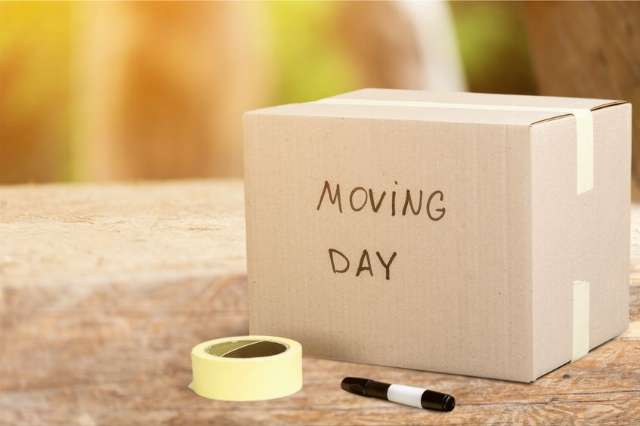How to Move on a Budget: Tips and Tricks for Moving Affordably

Moving is an exhilarating experience that marks the beginning of a new chapter in one’s life. However, the process comes with several struggles that make many dread the thought of relocation. One of the most common struggles many face is the cost of uprooting their lives and starting anew. Moving can be a stressful and expensive process, and it can be difficult to estimate the total cost of the move.
However, moving doesn’t always have to burn a hole in your pocket. Whether you’re a college student looking to move to student accommodation, a family transitioning to a new home, or an individual venturing to a new city, you will find that there are ways to save as much money on the move as possible. In this article, we will provide you with all the information you need to make this happen. Moreover, we’ll delve into tried-and-true strategies that have helped countless individuals and families move cheap. Here they are:
Make A Clear and Detailed Moving Plan

A well-structured moving plan is not just a roadmap that guides you through each phase of the relocation process; it’s also a strategic tool for significant savings. By being organized, staying on track, and anticipating challenges, you can avoid unexpected costs and make the most of every cent. A detailed moving plan is not just about organisation—it’s a blueprint for cost savings. By being proactive, strategic, and resourceful, you can ensure a smooth move that’s also easy on the wallet.
Create a timelines if you must. Start by determining your moving date and then work backward to establish a timeline. This proactive approach lets you capitalise on early-bird discounts, seasonal offers, or promotional deals.
To keep track of your moving plan and tasks better, use a moving house checklist.
Set A Budget for Your Move
Setting a budget for your move is the cornerstone of an affordable relocation. It’s not just about pinching pennies but about ensuring you have a clear financial roadmap for the journey ahead.
Reasons for Setting a Budget
Here’s a deeper dive into the importance and methodology of setting a moving budget:
Avoiding Unexpected Costs
Without a clear budget in place, it’s easy to overlook various expenses associated with moving. From packing supplies to potential additional insurance costs, there are numerous small expenses that can quickly add up. Setting a budget allows you to account for these costs ahead of time and avoid any unpleasant financial surprises.
Allocating Resources Wisely
A well-thought-out budget helps you prioritize where to spend and where to save. For instance, you might decide to splurge on a professional moving service but save by using recycled packing materials. By knowing your financial limits, you can make informed decisions that suit your needs and wallet.
Reducing Stress
Moving is inherently stressful, but much of this stress can be alleviated with proper planning. Knowing that you have a plan in place—and the funds to cover it—can provide peace of mind, allowing you to focus on other aspects of the move.
Time Management
A detailed moving plan helps you allocate your time efficiently. By setting a timeline for tasks like decluttering, packing, and notifying service providers, you ensure that everything gets done in a timely manner, reducing last-minute rushes and potential oversights.
Minimising Potential Losses
Planning reduces the risk of damages or losses during the move. For instance, you can ensure that fragile items are properly protected by scheduling enough time to pack carefully. Additionally, researching and choosing a reputable moving company can prevent potential mishaps.
Facilitating a Smooth Transition
Moving isn’t just about transporting items from one place to another; it’s about transitioning your entire life. Proper planning ensures that essential services, like utilities and mail, are set up in your new home promptly, making the settling-in process smoother.
Setting Realistic Expectations
By researching costs and setting a budget, you gain a realistic understanding of what your move will entail. This helps set expectations, ensuring you’re not caught off guard by the realities of the process.
Empowering Negotiations
When you clearly understand moving costs, you’re in a better position to negotiate. Whether it’s haggling the price with a moving company or negotiating the closing costs of a new home, knowledge is power.
How To Budget For A Move

Tip #1: Understand the Full Scope of the Move
Before you can set a budget, you need to understand the entirety of your move. Are you moving locally or across the country? Will you need temporary housing? The scope of your move will significantly influence your budget.
Tip #2: Break Down All Potential Expenses
List every conceivable cost associated with your move. This should include:
- Moving company or truck rental fees
- Packing materials and supplies
- Travel expenses (fuel, meals, accommodations)
- Storage fees, if needed
- Utility setup or transfer fees
- Potential repair or cleaning costs for your old residence
Tip #3: Research Costs in Advance
Once you’ve listed potential expenses, research each one to get an accurate estimate. For instance, get quotes from multiple moving companies or check the prices of packing supplies in local stores.
Tip #4: Prioritise and Make Trade-offs
Determine which expenses are non-negotiable and which ones offer some flexibility. Perhaps you can forego professional packers if it means being able to afford a more reliable moving company.
Tip #5: Set Aside a Contingency Fund
Even with the best planning, unexpected expenses can arise. It’s wise to set aside a portion of your budget (typically 5-10%) for unforeseen costs. This might cover things like last-minute packing supplies or an unplanned overnight stay.
Tip #6: Regularly Review and Adjust
As you progress with your moving preparations, keep an eye on your spending. If you notice you’re consistently going over budget in certain areas, review and adjust accordingly. This might mean reallocating funds from one category to another.
Tip #7: Be Realistic
While it’s essential to save, it’s equally crucial to be realistic about costs. Underestimating can lead to financial strain down the line. Always round up your estimates to give yourself a buffer.
Tip #8: Factor in Post-Move Expenses
Remember that settling into your new home might come with its own set of costs. From restocking the pantry to essential household items or minor repairs, ensure you have a budget allocation for post-move expenses.
Tip #9: Document Everything
Keep a record of all your expenses, no matter how minor. This helps you track your spending and will also benefit future moves, giving you a clear picture of costs to anticipate.
Setting a budget for your move is about foresight, research, and adaptability. By dedicating time to this process, you’re safeguarding your finances and ensuring a smoother, more predictable moving experience.
Assess Your Inventory

Systematically assess all your belongings. This not only helps you gauge the size of the moving truck or the number of boxes you’ll need, but also presents an opportunity to declutter. Selling items you no longer need can provide extra funds, while donating or discarding reduces moving costs.
Furthermore, by categorizing items, you can identify those that can be packed together, ensuring efficient use of space and materials. This step is crucial for moving affordably as it prevents over-purchasing packing supplies or renting a larger truck than necessary. After all, the price of removals vans often becomes more expensive as the van or trailer becomes bigger. The only alternative you’ll have when you are planning on moving a lot of items would be making multiple trips to your old house and the new place, and the cost of petrol and labour might just be the same as, if not more than the cost of renting or hiring a larger moving van.
Do Not Hesitate To Delegate Tasks
When moving with family or roommates, delegate tasks. This division of labour can save money by reducing the need for professional services. For example, if someone is adept at packing fragile items, you might save on specialised packing services. Additionally, pooling resources and sharing responsibilities can lead to collective savings. For instance, bulk buying packing materials or sharing equipment rental costs can make the process more affordable for everyone involved.
Research and Book Man and Van Movers

Begin your research on moving companies well in advance. This gives you ample time to compare quotes, negotiate better rates, and avail of any discounts or promotions. Early booking can also fetch you a better deal, especially during non-peak seasons. Remember, moving affordably often hinges on making informed choices. By reading reviews and seeking recommendations, you can find movers that offer quality services at competitive rates.
You may be wondering, “Why would I hire others to do the job for me? Wouldn’t that only cost me more money?” Well, at face value, yes. After all, hiring a man and van service comes with costs. However, when you delve deeper into the logistics of moving, especially if you’re relocating to a distant place or have a significant amount of belongings, the benefits of hiring professionals can outweigh the costs.
- Efficiency and Speed: Man and van services are experienced in the art of moving. They know how to load and unload items quickly, ensuring that the move is completed in the shortest time possible. This efficiency can save you money in the long run, especially if you’re paying for hourly services or if you need to take time off work to manage the move.
- Safety and Security: Moving heavy or bulky items without the proper equipment or expertise can lead to injuries or damage to your belongings. The potential medical bills or costs to replace or repair damaged items can quickly surpass the cost of hiring professionals. Man and van services come equipped with the necessary tools and knowledge to handle your items safely.
- Insurance Coverage: Most reputable man and van services offer insurance coverage for the items they transport. This means that in the unlikely event that something gets damaged during the move, you won’t be left footing the bill.
- Hidden Costs of DIY Moves: While it might seem cheaper to handle the move yourself, there are hidden costs to consider. Renting a vehicle, purchasing packing materials, fuel, potential overnight stays, and even the possibility of making multiple trips can add up. Not to mention the physical and mental toll of managing a move on your own.
- Tailored Services: Man and van services often offer a range of packages tailored to different needs. Whether you need help with packing, disassembling furniture, or just the transportation, you can choose a service that fits your budget. Plus, with the competitive nature of the moving industry, many companies are willing to negotiate or offer deals to secure your business.
While there’s an upfront cost associated with hiring a man and van service, the potential savings in time, effort, and unforeseen expenses can make it a more affordable option in the grand scheme of things. When aiming to move affordably, it’s essential to look beyond the initial price tag and consider the overall value and peace of mind that professional movers bring to the table.
To save money when hiring a man and van, remember these tips:
- Comparing Quotes: When considering a move, it’s essential to gather and compare quotes from various man and van services to gauge the average cost. Platforms like WhatManandVan can be invaluable in this process, offering a convenient way to compare rates from different providers. When requesting a quote, be thorough in providing details about your move to ensure the estimates you receive are as accurate as possible. While a low offer from a service might seem enticing, it’s crucial to approach such quotes with caution. Sometimes, an unusually low bid can be a red flag, hinting at hidden charges or potential compromises in service quality. With WhatManandVan, you can feel more confident in your choices, knowing you’re comparing reputable services.
- Asking for Discounts: Many companies offer discounts for moves during off-peak times or for repeat customers. It’s always worth inquiring about any available promotions or discounts. Additionally, some services might have referral programs, so if a friend recommended you or vice versa, there could be savings in store.
- Booking in Advance: Securing your move date well ahead of time can lead to savings. Companies appreciate knowing their schedule in advance and might offer incentives for those who book early. Conversely, last-minute bookings can come with a premium price tag due to the urgency and potential rescheduling of other jobs.
- Checking for Hidden Fees: When reviewing your quotes, ask for a clear breakdown of all costs to understand what’s included. Be on the lookout for additional charges like mileage, fuel, or fees for heavy items. It’s also wise to inquire about any potential fees associated with rescheduling or cancellations.
By paying close attention to these areas and maintaining open communication with potential service providers, you can navigate the process of hiring a man and van service confidently, ensuring both affordability and quality.
Packing Strategy
Formulate a cost-effective packing strategy. Can you source free boxes from local stores or use old newspapers for wrapping? Prioritize packing items that might be expensive to replace if damaged, and consider DIY packing solutions for them. Additionally, consider investing in reusable packing materials. Not only are they environmentally friendly, but they can also be cost-effective if you anticipate moving again in the future.
Alternative packing materials are also a great way to move affordably while being resourceful. Many items around your home can double as packing materials, reducing the need to purchase additional supplies. Here are some innovative alternatives to traditional packing materials:
- Clothing: Soft items like t-shirts, sweaters, and scarves can be used to wrap fragile items. They provide cushioning and protection, ensuring your breakables are safe during transit. Socks, in particular, are perfect for wrapping glassware or filling gaps in boxes.
- Bedding and Towels: Blankets, quilts, and towels can be used to cover large items like mirrors or televisions. They offer a thick protective layer against scratches and impacts.
- Reusable Grocery Bags: These sturdy bags are perfect for packing books, kitchenware, or other heavy items. Their handles make them easy to carry, and they can be folded up and stored for future use.
- Egg Cartons: These are excellent for packing small, delicate items like jewelry or trinkets. The individual compartments keep items separated and protected.
- Plastic Bins: If you have plastic storage bins at home, they can be used for moving. They’re durable, stackable, and can be reused for storage in your new home.
- Food Containers: Empty containers from items like butter or sour cream can be cleaned and used to pack small items. They’re especially useful for keeping screws and nails from disassembled furniture.
- Bubble Wrap Alternatives: If you don’t have bubble wrap on hand, consider using popped popcorn (unsalted and unbuttered) or inflated balloons for cushioning. They’re lightweight and can provide ample protection for fragile items.
- Old Magazines and Junk Mail: Instead of recycling them immediately, use pages from old magazines or junk mail to cushion or fill gaps in boxes.
- Digital Packing: While not a physical packing material, consider digitizing items like photos, documents, or CDs. This reduces the volume of items you need to move and ensures they’re preserved in digital format.
Remember, the key to moving affordably is resourcefulness. You can save money on packing materials and reduce waste by repurposing items you already have. It’s a win-win for both your wallet and the environment.
Notification List
Compile a list of all entities you need to inform about your move. Notifying service providers, banks, or subscription services in advance can prevent additional charges or ensure you avail of any relocation discounts they might offer. Moreover, some services may offer prorated refunds or credits for unused days, further aiding in moving affordably.
READ: Change Of Address Checklist: Everything You Must Know
Pack An Essentials Box

Assemble an essentials box with items you’ll need immediately. This prevents unnecessary expenses on arrival, like buying toiletries or takeout, because you can’t find your personal items or kitchen supplies. Consider this your “first night” kit, ensuring you have everything you need without resorting to costly last-minute purchases.
Plan for Pets and Plants
Consider cost-effective solutions for when you are moving your pets and plants. Maybe a friend can care for your plants, saving you the cost of special transportation. Look for budget-friendly pet boarding or consider a pet-friendly travel solution. Additionally, research pet relocation services that might offer bundle deals or discounts for multiple pets.
READ: Moving House With Plants: Tips On How To Move Plants With Care
Route Planning
If you’re self-moving, plan your route to save on fuel and avoid toll roads. Research in advance to find affordable lodging or dining options if your move requires overnight stays. Using apps or websites that track fuel prices can also help in identifying the cheapest places to refuel, ensuring you’re moving as affordably as possible.
Have A Clear Post-Move Strategy

Strategize for the initial days post-move. Setting up essential rooms first, like the kitchen, can save money by reducing the need for takeout. Also, consider DIY solutions for tasks like cleaning or furniture assembly instead of hiring professionals. Additionally, scout your new neighborhood for affordable local services or stores, ensuring you’re not overspending on basics after the move.
Final Thoughts
In conclusion, relocating doesn’t have to be synonymous with exorbitant costs. As we’ve explored in this article, there are numerous strategies and tips to ensure you move cheap without compromising on the safety and security of your belongings. Whether searching for the cheapest way to transport furniture in the UK or simply seeking the cheapest way to move house, it’s evident that affordable solutions are within reach with a bit of planning, research, and resourcefulness.
Remember, the cheapest moving methods often require combining DIY efforts and smart choices, like repurposing materials or leveraging alternative packing strategies. As you embark on your next chapter, keep these insights in mind, and you’ll ensure a smooth transition and protect your pocketbook. Safe and savvy travels to all those looking to move cheap and efficiently!
Meanwhile, here are some house moving tips you will find useful.